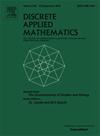哈密性的闭包和重对
IF 1
3区 数学
Q3 MATHEMATICS, APPLIED
引用次数: 0
摘要
我们说n个顶点上的图G是{H,F}- 0重的,如果G同构于H或F的每个诱导子图都包含两个不相邻的顶点,且度数和至少为n。推广了先前关于哈密性的充分禁止子图条件,在2012年,Li, Ryjáček, Wang和Zhang确定了除P3以外至少3阶的所有连通图R和S,使得每个2连通{R,S}- 0重图都是哈密的。特别地,他们证明了,为了达到对称性,R必须是一个爪,而S∈{P4,P5,C3,Z1,Z2,B,N,W}。在2008年,Čada通过引入我们称之为重爪图的c闭包,扩展了Ryjáček的无爪图闭包概念。我们在此应用它来描述2连通{R,S}- 0 -重图的c闭包结构,其中R和S如上所示。我们的主要结果扩展或推广了先前关于禁忌子图或重子图的哈密性的几个结果。本文章由计算机程序翻译,如有差异,请以英文原文为准。
Closures and heavy pairs for hamiltonicity
We say that a graph on vertices is --heavy if every induced subgraph of isomorphic to or contains two nonadjacent vertices with degree sum at least . Generalizing earlier sufficient forbidden subgraph conditions for hamiltonicity, in 2012, Li, Ryjáček, Wang and Zhang determined all connected graphs and of order at least 3 other than such that every 2-connected --heavy graph is hamiltonian. In particular, they showed that, up to symmetry, must be a claw and . In 2008, Čada extended Ryjáček’s closure concept for claw-free graphs by introducing what we call the -closure for claw--heavy graphs. We apply it here to characterize the structure of the -closure of 2-connected --heavy graphs, where and are as above. Our main results extend or generalize several earlier results on hamiltonicity involving forbidden or -heavy subgraphs.
求助全文
通过发布文献求助,成功后即可免费获取论文全文。
去求助
来源期刊

Discrete Applied Mathematics
数学-应用数学
CiteScore
2.30
自引率
9.10%
发文量
422
审稿时长
4.5 months
期刊介绍:
The aim of Discrete Applied Mathematics is to bring together research papers in different areas of algorithmic and applicable discrete mathematics as well as applications of combinatorial mathematics to informatics and various areas of science and technology. Contributions presented to the journal can be research papers, short notes, surveys, and possibly research problems. The "Communications" section will be devoted to the fastest possible publication of recent research results that are checked and recommended for publication by a member of the Editorial Board. The journal will also publish a limited number of book announcements as well as proceedings of conferences. These proceedings will be fully refereed and adhere to the normal standards of the journal.
Potential authors are advised to view the journal and the open calls-for-papers of special issues before submitting their manuscripts. Only high-quality, original work that is within the scope of the journal or the targeted special issue will be considered.
 求助内容:
求助内容: 应助结果提醒方式:
应助结果提醒方式:


